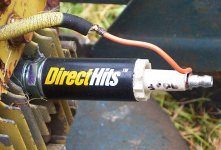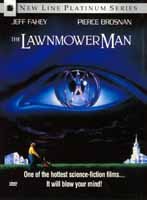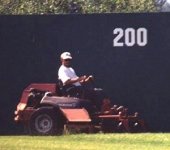The same way that audio is surrounded by false claims for devices supposed to give better sound, internal combustion engines have for a long time been subject to the same indignity. There have been many silly add-on devices for spark plugs for example, promising greater power, reduced fuel consumption etc. There was one though that caught my eye. It is basically a 90pF capacitor with very low series inductance, and it goes across the spark plug. The idea is that as the voltage rises the cap charges and then the plug gap breaks down and fires it causes the cap energy to be discharged in a *very* high current short duration arc. I was pretty skeptical, but a friend had one of these things and seeing it was just one only, I attached it to my motor mower(!) I had to get a plug that was the same thread length as the mower plug but also the full external length as a car plug. Anyway, what a difference! Cold starting was the same as usual but hot starting was way better, was more responsive to revving up, and ran quite a bit more steadily. (is a 4-stroke). Under high load you could feel the individual power strokes much more defined. Idling was a little improved. I have messed around with gasoline engines for about 30 years now, and in particular I *listen* to them. I could hear the difference straight away. I don't have any connection with this company. I'd recommend them to anybody. http://www.directhits.com/
Attachments
Hi Graham,
I too have messed around with infernal combustion engines for yonks.
Did you replace the spark plug at the same time at adding the 'Direct Hit' gadget?
There's a company called Crane Cams in Adelaide, SA, which produces multiple spark CDIs for passenger cars. These really work. I saw a dyno on a Walkinshaw Commodore with 242Kw at the back wheels. After fitting the MS CDI, and with no other changes, power increased to 270Kw. I suspect there is a great deal not yet understood about the ignition of fuel/air mixtures.
Cheers,
Hugh
www.aksaonline.com
I too have messed around with infernal combustion engines for yonks.
Did you replace the spark plug at the same time at adding the 'Direct Hit' gadget?
There's a company called Crane Cams in Adelaide, SA, which produces multiple spark CDIs for passenger cars. These really work. I saw a dyno on a Walkinshaw Commodore with 242Kw at the back wheels. After fitting the MS CDI, and with no other changes, power increased to 270Kw. I suspect there is a great deal not yet understood about the ignition of fuel/air mixtures.
Cheers,
Hugh
www.aksaonline.com
<b>I'd recommend them to anybody.</b>
For lawnmowers perhaps.
I haven't used these, but have seen enough crap touted as a performance part to be hugely sceptical. I've seen the damage they can do to hi-po motors, and there's no way I'd attach such things to the performance motors I play with, without some proof they don't do damage. Items like this come and go regularly, but good engineering is what works, and there are a number of great CDI and TAI modules available.
For lawnmowers perhaps.
I haven't used these, but have seen enough crap touted as a performance part to be hugely sceptical. I've seen the damage they can do to hi-po motors, and there's no way I'd attach such things to the performance motors I play with, without some proof they don't do damage. Items like this come and go regularly, but good engineering is what works, and there are a number of great CDI and TAI modules available.
I've used multi spark CDIs on cars for many years, and am very pleased with their effectiveness. Good engines will often have a very turbulent combustion space during the 'squeeze' part of the cycle, and can easily blow out the spark. Multi-sparking also helps keep the plugs cleaner, and a more even burn to the mix.AKSA said:There's a company called Crane Cams in Adelaide, SA, which produces multiple spark CDIs for passenger cars. These really work. I saw a dyno on a Walkinshaw Commodore with 242Kw at the back wheels. After fitting the MS CDI, and with no other changes, power increased to 270Kw. I suspect there is a great deal not yet understood about the ignition of fuel/air mixtures.
Like your experience with the Walkinshaw, I've seen MS CDI units make big differences on the dyno. I've also seen some engines not make any significant difference with the same ignition and fuel mapping, yet a very large one when tweaked to optimise for the MS CDI. Lots of the performance increase is had at lower RPMs (below peak torque) and during the ramp up between lower RPM/low load and higher rpm/higher load conditions, ie responsiveness, often a more important attribute than outright power.
I spent part of today working on a mate's turbo 13B, doing the intake and exhaust design, looking for 400 + streetable, reliable HP with a fat midrange and very responsive. My last 13B turbo was 350-ish HP, but it only had to push 800kg.
Gidday Hugh! Yep, I did but the old plug wasn't so terribly bad anyway, although there is some room for error I'll admit. The spark pictures on their website are no exaggeration. On my bench it changes a 1/2 inch spark from a nice "snap" to a good solid "crack" and very much brighter. Extremely short duration though, but it doesn't seem to matter. I actually cranked the thing so hard I drew an arc down the side of the white insulator and also set the coil tower on fire.AKSA said:Hi Graham,
Did you replace the spark plug at the same time at adding the 'Direct Hit' gadget?
CDI vs TAI
In recent years I have leaned toward TAI rather than CDI for various reaons, but as you probably well know there are good and bad examples of both. But I will say this - I can't remember the exact details (but I can find out), a local fellow had an LH or LX Torana with small block Chev and *hydraulic* cam and it was in the VERY low 10 second bracket. He finally yanked out AUD$1700 worth of MSD ignition stuff and put in one of our microcontroller TAI boxes and associated stuff and woohoo! he became the first in the world to get a SBC/hyd cam car into the 9 sec bracket. Ahhh.... the track must have been downhill that day.Brett said:I've used multi spark CDIs on cars for many years, and am very pleased with their effectiveness.
Snake-oil...
There is a lot of it around...
Problem with ignition enhancers, is that we don't want a short duration spark! We want fat and long! And this requires energy!
And, somethimes we don't want fat & long, because it wears out the cap/rotor/wires/plugs........
And, also remember the different load-modes & rpm & temp & mixture-changes for an automotive engine...makes the ignition demand shift all the time.
I have tried most types ignition systems, and none is ideal all the time, but the newer multi-spark systems usually gets the job done better (IMHO). Y(racing/street)MMV.
Arne K
There is a lot of it around...
Problem with ignition enhancers, is that we don't want a short duration spark! We want fat and long! And this requires energy!
And, somethimes we don't want fat & long, because it wears out the cap/rotor/wires/plugs........
And, also remember the different load-modes & rpm & temp & mixture-changes for an automotive engine...makes the ignition demand shift all the time.
I have tried most types ignition systems, and none is ideal all the time, but the newer multi-spark systems usually gets the job done better (IMHO). Y(racing/street)MMV.
Arne K
Seems that those interested in Audio are also interested in performance engines. I am curious as to how old your lawn mower is? It has been my experience that most lawn mowers run a pretty rich mixture to ensure an easy burn. For a rich mixture, having a "massive" spark could definately enhance the performance. However, I would be very concerned when running with a lean mixture engine such as most car engines are these days. The problem with those big sparks is that similar to using an explosion to put out a fire, the big spark asks as an explosion and blows all the mixture away from the spark. I think it will all depend on how the combustion chamber is designed, how the chamber swirls during compression, etc. As long as it does not change the timing, I would not expect serious damage to a vehicle, and even if it does change the timing, most modern engine controllers will at least avoid detonation. I could see it interfering with modern ignition systems where the ingition coil is actually used more like a transformer and the spark is actually monitored to see what happens. In this case, that extra capacitor could prevent the ingition "amplifier" for lack of a better word, see the load "spark plug" properly.
FYI, I am very interested in any new ingition systems for Nissan 3.5L VQ series engines. Jacops ingitions systems have made it into a few of my cars in the past with great results, especially after the other modifications, but I don't think they are quite the leaders they once were.
Alvaius
FYI, I am very interested in any new ingition systems for Nissan 3.5L VQ series engines. Jacops ingitions systems have made it into a few of my cars in the past with great results, especially after the other modifications, but I don't think they are quite the leaders they once were.
Alvaius
Audio stuff and performance engines both produce very nice sounds when they are runnning properly. That must be the connection. Nothing like the sound of a 7000rpm V8alvaius said:Seems that those interested in Audio are also interested in performance engines. I am curious as to how old your lawn mower is? However, I would be very concerned when running with a lean mixture engine such as most car engines are these days. Alvaius
 The mower has a 3.5 HP Briggs and Stratton and I got it second hand at a junk auction. I would guess it is mid 70's. I just did a valve grind on it recently but apart from that the compression is pretty low. The whole thing is about as low tech as things can get. Side-valve you know.
The mower has a 3.5 HP Briggs and Stratton and I got it second hand at a junk auction. I would guess it is mid 70's. I just did a valve grind on it recently but apart from that the compression is pretty low. The whole thing is about as low tech as things can get. Side-valve you know. I spent part of today working on a mate's turbo 13B, doing the intake and exhaust design, looking for 400 + streetable, reliable HP with a fat midrange and very responsive. My last 13B turbo was 350-ish HP, but it only had to push 800kg. [/B]
Rotors are YUMMY!
The Honda guys are always towting there hp/liter numbers, but I was always like come on, 1.3L engine rated factory at 276 HP....I think that beats just about ANY car!
Incedentilly, I come here because I used to be into cars (well still am, but not nearly as much). Its just way too expensive for me right now. But I do have a 2.0L CRV engine with big 'ol crower cams and 12:1 JE pistons waiting to go in my Integra. It's just that I spent $2500 on that alone and still need to sink more money for install part stuff.
Wuuuuzzzzzz.......BANG.......wuuuuuzzzz = rotary shifting gears ;-)

I used to have a Villiers 2-stroke powered mower about 5 years ago and for a couple of months I had a large 12v gel cell and a MSD7-A and Bosch HEI coil on it. I kid you not. Actually it didn't go one scrap better at all. I even had the plug gap at 80 thou.
Actually it didn't go one scrap better at all. I even had the plug gap at 80 thou.
I always wind down the window if a buzzer goes past. Or listen to a bridge-ported one at the lights making that tinny "brrrt-brrrt-brrrt".mrfeedback said:Graham, you should put your Victa on a dyno.....
Eric.
I used to have a Villiers 2-stroke powered mower about 5 years ago and for a couple of months I had a large 12v gel cell and a MSD7-A and Bosch HEI coil on it. I kid you not.
Cutting edge research by me ;-)
I pulled the plug out of the mower and opened up the gap from 25 thou to 50 thou. I reasoned that it would take double the voltage to fire it, and this would cause the HV capacitor thingy to store and consequently dump 4 times the energy. It actually went even a little better than before, though not as big an improvement as at first.
Here's some further reading ->
R. Maly, B. Saggau, E. Wagrner, and G. Ziegler, "Prospects of Ignition Enhancement", SAE Paper 830478, Feb., 1983.
R.W. Anderson, "The Effect of Ignition System Power On Fast-Burn Engine Combustion", SAE Paper 870549, Feb., 1987.
R.W. Anderson and J.R. Asik, "Lean Air-Fuel Ignition System Comparison In a Fast-Burn Engine", SAE Paper 850076, Feb., 1985.
M.A. Ward, "A New Spark Ignition System For Lean Mixtures Based on a New Approach to Spark Ignition", SAE Paper 890475, Feb., 1989.
R.C. Pate, R.E. Hensley, "Combustion Initiation System Employing Hard Discharge Ignition", U.S. Patent No. 4,589,398, May 20, 1986
R. Maly, "Spark Ignition: Its Physics and Effects on the Internal
Combustion Process", published in: "Fuel Economy in Road Vehicles Powered By Spark Ignition Engines", Hilliard, J.C. and Springer, G.S. (Ed.), Plenum, New York, 1984
10th IEEE International Pulsed Power Conference, Albuquerque, New Mexico, 1995 W. Baker and G. Cooperstein, Editors
Library of Congress Number 95-78039, IEEE Catalog Number 95CH35833, IBSN 0-7803-2790-x (softbound) ...
"ADVANCED AUTOMOTIVE IGNITION SYSTEMS", G.J. Rohwein, S.R. Babcock, M.T. Buttram, Sandia National Laboratories, USA; L.S. Camilli, HDI Systems, Inc. USA; pg. 40
I pulled the plug out of the mower and opened up the gap from 25 thou to 50 thou. I reasoned that it would take double the voltage to fire it, and this would cause the HV capacitor thingy to store and consequently dump 4 times the energy. It actually went even a little better than before, though not as big an improvement as at first.
Here's some further reading ->
R. Maly, B. Saggau, E. Wagrner, and G. Ziegler, "Prospects of Ignition Enhancement", SAE Paper 830478, Feb., 1983.
R.W. Anderson, "The Effect of Ignition System Power On Fast-Burn Engine Combustion", SAE Paper 870549, Feb., 1987.
R.W. Anderson and J.R. Asik, "Lean Air-Fuel Ignition System Comparison In a Fast-Burn Engine", SAE Paper 850076, Feb., 1985.
M.A. Ward, "A New Spark Ignition System For Lean Mixtures Based on a New Approach to Spark Ignition", SAE Paper 890475, Feb., 1989.
R.C. Pate, R.E. Hensley, "Combustion Initiation System Employing Hard Discharge Ignition", U.S. Patent No. 4,589,398, May 20, 1986
R. Maly, "Spark Ignition: Its Physics and Effects on the Internal
Combustion Process", published in: "Fuel Economy in Road Vehicles Powered By Spark Ignition Engines", Hilliard, J.C. and Springer, G.S. (Ed.), Plenum, New York, 1984
10th IEEE International Pulsed Power Conference, Albuquerque, New Mexico, 1995 W. Baker and G. Cooperstein, Editors
Library of Congress Number 95-78039, IEEE Catalog Number 95CH35833, IBSN 0-7803-2790-x (softbound) ...
"ADVANCED AUTOMOTIVE IGNITION SYSTEMS", G.J. Rohwein, S.R. Babcock, M.T. Buttram, Sandia National Laboratories, USA; L.S. Camilli, HDI Systems, Inc. USA; pg. 40
alvaius said:Seems that those interested in Audio are also interested in performance engines. I am curious as to how old your lawn mower is? It has been my experience that most lawn mowers run a pretty rich mixture to ensure an easy burn. For a rich mixture, having a "massive" spark could definately enhance the performance. Alvaius
Hi,
Mowers run rich mixture to to ensure a cooler burn. Sounds backwords, but more fuel = cooler engine. Same reason some hogs have blue pipes, too lean.
It may also have to do with the inital ignition energy. I don't remember exactly, but I think that there is a correlation between ignition energy and propogation speed of the flame front. Faster snap may mean faster burn.
Not sure on the energy and speed thing. I have a friend I'll have to check with.
-Dan
- Status
- This old topic is closed. If you want to reopen this topic, contact a moderator using the "Report Post" button.
- Home
- General Interest
- Everything Else
- Looks like snake-oil but really works.


